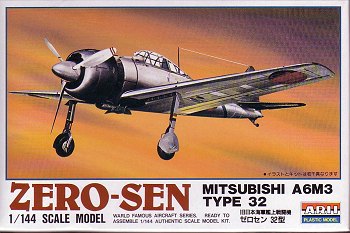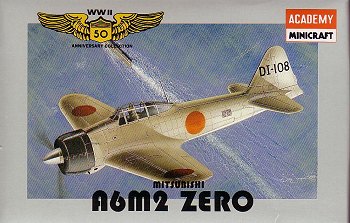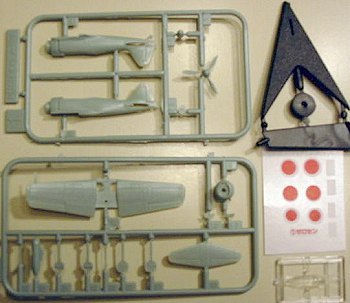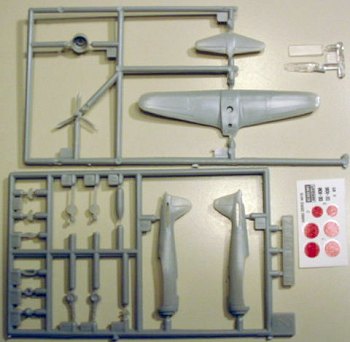 |
 |
|
KITS: |
Arii A6M3 type 32 /Minicraft A6M2 |
|
KIT # |
32026 / 4416 |
|
PRICE: |
@$3.50 each |
|
DECALS: |
basic markings |
|
REVIEWER: |
|
|
NOTES: |
More similarities than differences |
 |
 |
|
HISTORY |
Enough has been written about the Zero, so I won’t go into a long history of the type here. These two kits represent two different versions of the Zero:
The A6M2 Type 11 was the first main production version of the famed Zero series of fighters. It was followed by the A6M2 Type 21, which included manually-operated folding wingtips, which made the plane easier to handle aboard carriers.
The A6M3 Type 32 entered production in autumn of 1941. The previous model had folding wingtips—the Type 32 deleted the folding part, giving the wing a more squared-off appearance. The loss of the wing area caused a slight drop in turning ability, but the weight savings yielded a higher speed. Another improvement added to the Type 32 was a supercharger, which improved the performance of the aircraft at high altitudes.
|
THE KITS |
 < The Arii Kit
(A6M3 Type 32)
< The Arii Kit
(A6M3 Type 32)
Arii released a series of 6 Japanese aircraft in this scale. The Zero is number 1 of the series. Other aircraft in the series include the Kate and Val previewed earlier here on MM. All of the kits are similar in design and parts breakdown. They are decent kits, but not quite up to the molding standards of the newer 1/144 scale models from Sweet.
 The Minicraft kit
(A6M2 Type ?) >
The Minicraft kit
(A6M2 Type ?) >
Minicraft also released a series of 1/144 scale WW2 aircraft. The Zero is kit number 16 in the series. The Minicraft series includes both fighters and bombers, and includes both Pacific and European theater aircraft. This is the first aircraft from the series that I have looked at. It is not clear whether the kit represents the Type 11 or the Type 21. (Editor's Note: the type 11 did not have a tail hook or folding wing tips as it was land based only)
The Similarities:
The kits are very similar in parts breakdown and layout. Both kits have about 20 parts. The following comments apply to both kits:
The fuselage consists of left and right halves, and a cowling/engine. Two prop hubs are provided—one with and one without prop blades. There is no engine detail inside the cowling. There are no cockpit parts, nor any interior detail at all. The cockpit consists of an appropriately shaped hole in the top of the fuselage, covered by a one-piece clear canopy. The canopy looks pretty good- not too thick, decent framing moldings, and clear.
The wing is a one piece unit. The instructions show that the landing gear can be installed in the raised or lowered position. There is a one-piece centerline drop tank included. The stab is also a one-piece unit.
Both kits had a little flash on the props and landing gear. The Arii kit is molded in a light blue-grey plastic, while the Minicraft version is molded in a light gray color.
The decal sheet provides basic markings for one aircraft. The decal sheet has six hinomarus and lettering for the tail.
The Differences:
Compared to the Minicraft kit, the Arii kit has more panel line detail, but the lines on the Minicraft kit are generally finer. The wheel wells on the Minicraft kit are shallower than the one on the Arii kit- the gear up option will take some sanding to get the gear to fit, I think.
The Minicraft kit has noticeably fewer panel lines on the fuselage. The Minicraft kit has a separate piece for the tailwheel, and there is no display stand.
Both kits have simple pictorial instructions on a half sheet of A4-sized paper. The Minicraft kit includes a nice 3-view of the aircraft on the back side, with painting instructions for an aircraft in overall light gray.
The Arii kit has no painting instructions, except for a color profile on the side of the box, showing a dark green over gray color scheme.
The decal sheet for the Arii kit does not look to be too good—the red of the markings is sort of washed out, and the white borders on the fuselage markings were printed out of register. The tail codes are significantly oversized, too.
The Minicraft kit includes the same markings, but the decal sheet looks to be a lot better. The red is a lot redder, and the decals look to be thinner.
|
CONCLUSIONS |
If I was only going to build one Zero in 1/144, I’d pick the Minicraft kit over the Arii, primarily because of the better decal sheet. However, the Arii kit isn’t bad, and given that both kits are OOP, I’d take the Arii kit if it was the only one I could find.
Review kits courtesy of my wallet. The Minicraft kit can still be found in shops, but I haven’t seen the Arii model for several years.
|
REFERENCES |
A6M Zero in Action, Squadron/Signal Publications Aircraft Number 59, by Shigeru Nohara.
If you would like your product reviewed fairly and quickly by a site that has over 200,000 visitors a month, please contact me or see other details in the Note to Contributors.